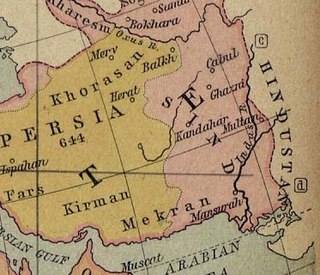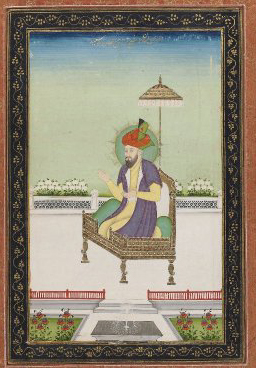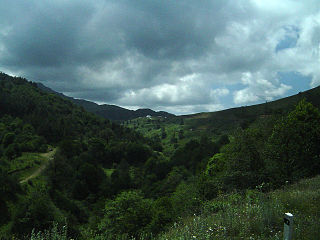
Babur was the founder of the Mughal Empire in the Indian subcontinent. He was a descendant of Timur and Genghis Khan through his father and mother respectively. He was also given the posthumous name of Firdaws Makani.
The Yusufzai or Yousafzai, also referred to as the Esapzai, or Yusufzai Afghans historically, are one of the largest tribes of ethnic Pashtuns. They are natively based in the northern part of Khyber Pakhtunkhwa, to which they migrated from Kabul during the 16th century, but they are also present in parts of Afghanistan, including Kunar, Kabul, Kandahar and Farah. Outside of these countries, they can be found in Ghoriwala District Bannu, Balochistan Sibi (Akazai), Chagai (Hassanzai) and Rohilkandh.

The Timurid Empire was a late medieval, culturally Persianate Turco-Mongol empire that dominated Greater Iran in the early 15th century, comprising modern-day Iran, Iraq, Afghanistan, much of Central Asia, the South Caucasus, as well as parts of contemporary Pakistan, North India and Turkey. The empire was culturally hybrid, combining Turko-Mongolian and Persianate influences, with the last members of the dynasty being "regarded as ideal Perso-Islamic rulers".

Sultan Husayn Bayqara Mirza was the Timurid ruler of Herat from 1469 until May 4, 1506, with a brief interruption in 1470.
The Arghun dynasty ruled over the area adjoining Southern Afghanistan and then the Sindh Sultanate from the late 15th century to the early 16th century. Arghun rule can be divided into two branches: the Arghun branch of Dhu'l-Nun Beg Arghun that ruled until 1554, and the Tarkhan branch of Muhammad Isa Tarkhan that ruled until 1593.
Qutlugh Nigar Khanum was the first wife and chief consort of Umar Shaikh Mirza II, the ruler of Ferghana Valley. She was a princess of Moghulistan by birth and was a daughter of Yunus Khan, the Great Khan of Moghulistan.

Yunus Khan, was Khan of Moghulistan from 1462 until his death in 1487. He is identified by many historians with Ḥājjī `Ali, of the contemporary Chinese records. He was the maternal grandfather of Babur, founder of the Mughal Empire.

In 1504, Babur besieged Kabul and took the city from the Arghuns under Mukim Beg Arghun, to become the new king of Kabul and Ghazni regions. The territory gave him respite from his Uzbek troubles in Central Asia. It allowed him to build his nascent kingdom into a strong and formidable power in later years, enough to conquer northern India.

After the death of King Abu Sa'id Mirza, the great-grandson of Amir Timur Beg Gurkani, his much reduced Timurid Empire was divided among four of his sons namely;

Abu Sa'id Mirza was the Ruler of the Timurid Empire during the mid-fifteenth century, and he was the Paternal Grandfather to the Mirza Zahiruddin Muhammad Babur Badshah Ghazi whos founding the Moghul Empire in South Asian Subcontinent in 1526 AD, Abu Sa'id born a minor prince of the Timurid dynasty, Abu Sa'id quickly established himself as the most prominent among his warring relations. Over the course of two decades, he reunified much of the Timurid Empire, which had become fractured in the aftermath of the death of his great-uncle Shah Rukh. However, Abu Sa'id's hopes of restoring the empire to its former extent at the time of Timur ultimately failed after he was killed during an invasion of what is now western Ir.n.
Abul-Qasim Babur Mirza, was a Timurid ruler in Khurasan (1449–1457). He was the son of Ghiyath-ud-din Baysunghur ibn Shah Rukh Mirza, and thus a great-grandson of Amir Timur.

Sultan Muhammad Mirza was a Timurid Dynasty Prince and Grandson of the Central Asian Mongol conqueror Timur by his third son Miran Shah. Little is known about his life, though through his son Sultan Abu Sa'id Mirza, he was the great-grandfather of Babur, founder of the Mughal Empire of South Asian Subcontinent.

Umar Shaikh Mirza II was the ruler of the Fergana Valley. He was the fourth son of Abu Sa'id Mirza, the emperor of the Timurid Empire in what is now Kazakhstan, Uzbekistan, Afghanistan and eastern Iran.
Badi' al-Zaman Mirza was a Timurid ruler of Herat from 1506 to 1507. He was the son of Husayn Bayqarah, who was a great-great-grandson of Timur.

The Battle of Qarabagh was fought on February 4, 1469, between Aq Qoyunlu under Uzun Hasan, and the Timurids of Samarkand under Abu Sa'id Mirza, resulting in the latter's defeat, imprisonment and execution. After the battle, the Timurids forever lost any hopes of gaining Iraq or Iran back into their kingdom.

Khanzada Begum was a Timurid princess and the eldest daughter of Umar Shaikh Mirza II, the amir of Ferghana. She was also the elder sister of Babur, the founder of the Mughal Empire. She and her brother remained deeply attached to each other all their lives, a period during which the family progressed from ruling a tiny and obscure principality in Central Asia to ruling a large portion of the Indian subcontinent. Babur conferred on his sister, the honorable title of Padshah Begum and she was really the first lady of his Empire after his death.
Maham Begum or Mahim Begum was the Empress consort of the Mughal Empire from 20 April 1526 to 26 December 1530 as the third wife and chief consort of Babur, the founder of the Mughal Empire and the first Mughal emperor. She was the mother of Babur's eldest surviving son and eventual successor, Humayun.
Rukn-ud-din Ala al-Dawla Mirza, also spelt Ala ud-Dawla and Ala ud-Daula, was a Timurid prince and a grandson of the Central Asian ruler Shah Rukh. Following his grandfather's death, Ala al-Dawla became embroiled in the ensuing succession struggle. Though he initially possessed a strategic advantage, he was eventually overtaken by his more successful rivals. Ala al-Dawla died in exile after numerous failed attempts to gain the throne.
Jahangir Mirza II was the second son of Umar Sheikh Mirza and half brother of Babur, the founder of the Mughal Empire. He was two years younger to Babur and his mother, Fatima Sultan, belonged to the clan of Mughal Tuman Begs.
Malak Ahmad Khan Yusufzai (1460–1530) also known as Malak Ahmad Baba was an Afghan chief and warrior. He belonged to the Razar Mandanr clan of the Yousafzai. Ahmad Khan's life was spent in fighting and resettling the Yusufzai in modern Khyber Pakhtunkhwa, Pakistan. The Yusufzai fought the Dilazak and Sultan Awais Swati for control of northern KPK. The Dilzaks had initially given refuge to the Yusufzai before they were driven out by them. After being expelled, Malak Ahmad Khan replaced his uncle Malak Suleiman Shah as the chief of the Yusufzai. Through Bibi Mubarika marriage to Babur, the Yusufzai finally made peace with the Mughals and were able to establish their stronghold in Dir, Swat, Buner, Malakand, Swabi and Mardan with Thana, Malakand as the capital. Bibi Mubarika was the daughter of Shah Mansur, who was the son of Malak Suleiman Shah and the cousin of Malak Ahmad Khan.











